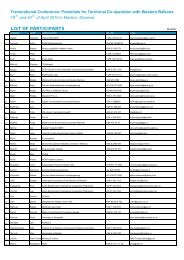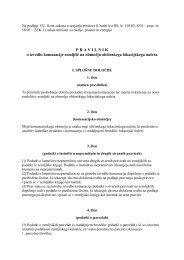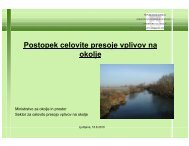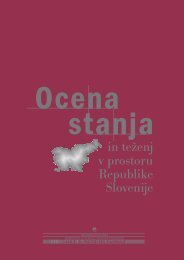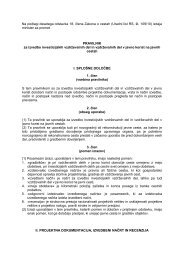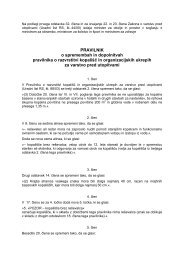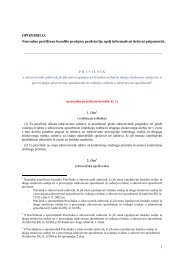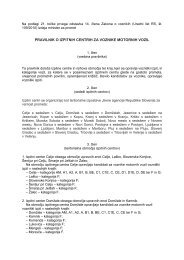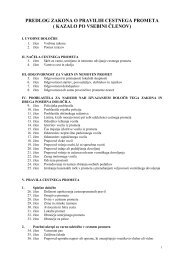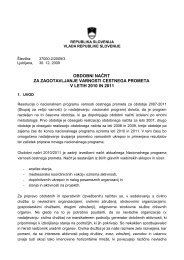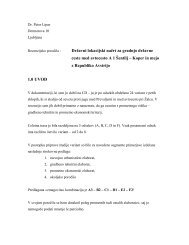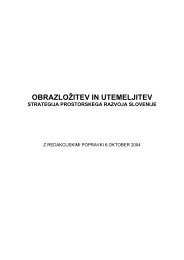evropska konvencija o krajini - Ministrstvo za infrastrukturo in prostor
evropska konvencija o krajini - Ministrstvo za infrastrukturo in prostor
evropska konvencija o krajini - Ministrstvo za infrastrukturo in prostor
Create successful ePaper yourself
Turn your PDF publications into a flip-book with our unique Google optimized e-Paper software.
134Delavnica 2 / Workshop 2kmetijstva, <strong>prostor</strong>skega načrtovanja, regionalnegarazvoja, turizma <strong>in</strong> prometa najpomembnejšeukrepe, s katerimi vplivajo na kulturnokraj<strong>in</strong>o.Kmetijska politika premore številne ukrepe, ki so<strong>za</strong> območje Alp posebej pomembni: podpore <strong>za</strong>kmetijska gospodarstva z omejenimi naravnimidejavniki kompenzirajo manjšo konkurenčnostkmetij <strong>za</strong>radi naravnih danosti, kmetijsko-okoljskiukrepi pa podpirajo ekstenzivno, okoljsko varnokmetijstvo na manjših enotah. Ti ukrepipredvsem <strong>za</strong>gotavljajo dohodke iz kmetijstva <strong>in</strong>prispevajo k ohranjanju kmetovanja v Alpah. Vtem pogledu se zdi uravnoteženje slabihnaravnih danosti z denarnimi podporamiupravičeno <strong>in</strong> še naprej smiselno. Vendar pakoncept vitalnega podeželja <strong>za</strong>hteva ohranjanjekmetijstva kot gospodarske dejavnosti, <strong>za</strong>to jeključno, da se to omogoči tudi alpskimkmetijam. Ker je masovna proizvodnja mogočale na zelo redkih gospodarstvih, je treba iskatidruge možnosti <strong>za</strong> uveljavljanje na trgu.Povezovanje znotraj kmetijskih regij ter medkmetijstvom <strong>in</strong> drugimi sektorji je treba izboljšati.Priložnost je lahko nave<strong>za</strong>va na turistični sektorv regiji <strong>in</strong> bližnja urbana središča, kar pa <strong>za</strong>htevaprilagoditev ponudbe, predvsem v smeriorganskih <strong>in</strong> ekološko pridelanih produktov.Kmetijski politiki manjkajo predvsem<strong>in</strong>ovativnost, <strong>prostor</strong>ski pristopi <strong>in</strong> boljd<strong>in</strong>amičen pogled na kulturno kraj<strong>in</strong>o <strong>in</strong>21. Prvi trend v alpskih kraj<strong>in</strong>ah: Koncentracija rabe v dol<strong>in</strong>ah, s prepletom stanovanjskih, proizvodnih,<strong>in</strong> turističnih dejavnosti, prometne <strong>in</strong>frastrukture ter kmetijske rabe. (Fotomontaža: RegAlp)development;– protection areas for nature and culturallandscape.Despite the extensive survey of the exist<strong>in</strong>gknowledge about the impacts of policies on the<strong>in</strong>teractions between development and culturallandscape, it was evident that the evaluation ofpolicy effects was a very difficult task, due to thehigh complexity of the issue as well as to a lackof concepts, tools and data. One of the f<strong>in</strong>d<strong>in</strong>gwas that <strong>in</strong> the presence of global economic(globalisation of markets), demographic (age<strong>in</strong>gof the population, immigrations) and naturalprocesses (climate change), the studied policiesare only to a very limited extent able to reduceunfavourable regional trends like spatial polarisationor segregation of land-use. However, thestudied policies can contribute to an attenuationof negative impacts, and may have some importanceon regional and local level. In this view,agricultural, spatial plann<strong>in</strong>g, regional development,tourism and transport policies seem to bethe ones with most important <strong>in</strong>struments toimpact cultural landscape.Agricultural policy provides several <strong>in</strong>struments,which are especially important for the alp<strong>in</strong>earea: the payments for less-favoured areas compensatethe natural competition disadvantagesof the alp<strong>in</strong>e agriculture; agri-environmentalmeasures support the ma<strong>in</strong>tenance of an extensive,environmentally sound and small-scale alp<strong>in</strong>eagriculture. These measures safeguard theagricultural <strong>in</strong>comes and contribute to the ma<strong>in</strong>tenanceof the agricultural cultivation of theAlps. Thus, the high f<strong>in</strong>ancial support for alp<strong>in</strong>eagriculture appears justified and the natural disadvantagesof mounta<strong>in</strong> agriculture should befurther compensated. However, the concept ofa »vital countryside« requires keep<strong>in</strong>g agriculturean economic activity, so the alp<strong>in</strong>e agricultureneeds to be economically strengthened. S<strong>in</strong>cemass production is an option only for a very limitednumber of alp<strong>in</strong>e farmers, the farmers <strong>in</strong>less favoured areas have to f<strong>in</strong>d additional opportunitiesto w<strong>in</strong> their position <strong>in</strong> the market. Theregional tourism sector and nearby urban marketsmay be promis<strong>in</strong>g options but require adaptationof the supply. Organic farm<strong>in</strong>g and ecologicallysound forms of cultivation should thereforebe promoted. Furthermore, the developmentof rural regions and the co-operation betweenagriculture and the other sectors shouldbe enhanced. But <strong>in</strong>novative and territorial ap-



